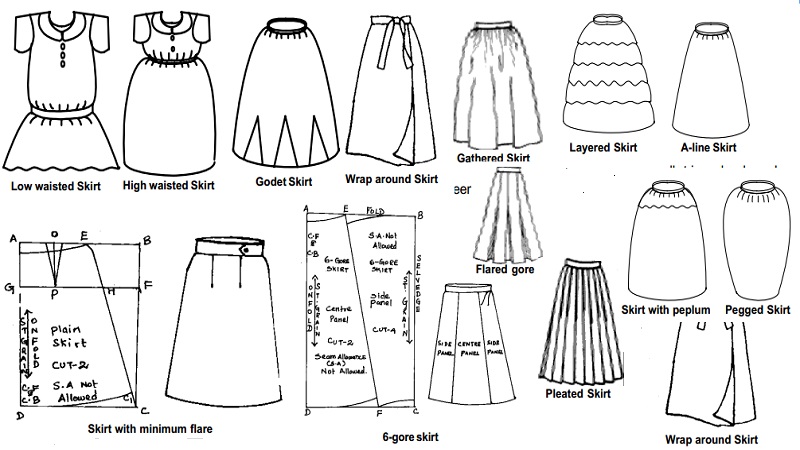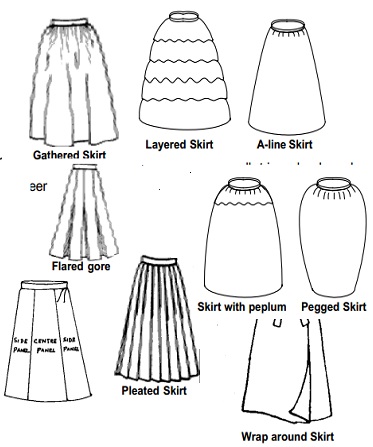Chapter: 11th 12th std standard Textiles And Dress Designing Cloth stitch Higher secondary school College practical steps methods Notes
Skirt types based on length and on design

SKIRTS
INTRODUCTION:
A skirt is a garment which covers the lower part of a figure from the waist to the hem, ending at any desired length. A skirt can be decorated with any type of fullness or it can cling to the body. It is generally simpler to design a skirt pattern than a bodice, because skirts are less intricately shaped. Skirt outlines and lengths vary tremendously with fashion.
The silhouette can be narrow, flared or bouffant; even straight skirts can vary from extremely tight and narrow at the hem to slightly A-lined.
The length of a skirt is always important. To a certain extent it depends upon the wearer's age and the occasion on which the garment is worn, but the length should always be in line with current trends.
SKIRT TYPES:
The skirt can be classified depending upon its length and its design.
a. Skirt types based on length:
1. Micro Mini:
In this type of skirt the length of skirt extends 10' from the waist above the mid thigh.
2. Mini Skirt:
If the skirt's length ends at mid thigh level then it is called mini skirt. (3'-5' below crotch).
3. Normal Skirt:
The length of the normal skirt is 2-3' just below the knee.
4. Ballerina Skirt:
The skirt which ends at mid calf level is called ballerina skirt.
5. Maxi Skirt:
This type of skirt's extends till the ankle or floor level. The above proportions vary slightly, according to fashion and customers taste.


b. Skirt Types based on design:
There are many types of skirt designs as given below:
1. Basic Skirt:
This skirt will have the darts of equal lengths in the form of fullness at the waist line in the front and back. The pattern obtained can be used as the base for any other skirt with a hemline sweep that is equal on the front and back.
2. Skirt with minimum flare:
This type of skirt fits the waist tightly with only two darts and has only 1' to 2' ease allowance on the hipline. About 2' flare is added on the side seam of skirt for freedom of movement.
Instruction of Drafting :
Draw rectangle ABCD, where AB = � hip + 2�' (�' - ease; 2' - flare at hemline) & BC = skirt length. Mark AG - BF = Waist to hip measurement (usually - 6' to 9'). Join GF . AE = � waist + 1� (1' for dart; �' for ease allowance). AA1 =�'. Join A1 E ;GH - � Seat + �' for ease allowance. Join EHC Mark CC1 = 1'. Mark points �' on either side of O and connect to P.
3. Gathered Skirt:
Skirts with gathers at waistline requires extra width in the pattern frame and at the side seams. Amount of increase in the width depends upon the amount of gathers required and the fabric thickness. Bulky fabrics can have limited fullness as there will be difficulty in stitching it to the waistline. If amount of gathers are more, light weight fabrics can be used. If amount of gathers are more, take the length of fabric according to the length of the skirt +2' (for folding) and width of the skirt must be twice the amount of waist circumference for gathering. Finish the side seam and do casing and insert tape or elastic. Finish the hem edge using machine stitch. Take care to keep the sleeve edge in lengthwise direction
4. Pleated skirt:
A skirt in which extra fullness at the waistline is accommodated in the pleats. A pleat is a fold in the fabric that releases fullness. Skirt can have pleat at different positions all over. They may be folded and left unpressed or pressed, may be grouped or left ungrouped with or without even spacing. Pleats may be formed in a variety of ways and named accordingly, for eg. knife pleated skirts, box pleated skirt, inverted pleat skirt, accordion pleated skirt and sunburst pleated skirt.
5. Gored Skirt:
A gored skirt is one with panels which are narrow at the waistline and wider at the hemline. It can have any number of gores which can be equally or unequally spaced as 'desired' by the wearer. The gore may be angled, flared, pleated or may be straight from the hip level. The common types of gore skirt are usually 6-gore and 4-gore skirt. The instructions for drafting 6 gore skirt is given below:
Draw a rectangle ABCD, where AD = Skirt length; AB = 16' (Remove 4' for band along the width of the fabric and remaining 32' in folded). AE = CF = 1/8 waist + � ' ease allowance. Join EF Leave �' below A, E, C, F.
Draw curved lines on all these points to make a skirt.
6. Circular skirt:
Select a fabric of maximum width for this type of skirt. This will not have any side seam. The fabric must be folded lengthwise as well as crosswise of same size square for this Skirt. To prepare the pattern draw a square ABCD, where = AB = CD = 1/6 waist +
Skirt length AE = AF = 1/6 waist. Join BD Diagonally. Join EF.AE = OP = FC = Skirt length. Join APC.
7. Skirt with extra flared gore:
If extra fullness is required at hem level. eg. sports skirt, or a long evening dress, it can be added to each gore. This addition is usually made from the hemline, but on A line skirt it could start from about knee level. A long 6-gored skirt can be flared out below the knee.
8. Layered Skirt:
These are also called tiered skirts which has rows or layers of fabric attached to each other at the hemline. The width of each layer may be graduated or of even lengths. Length as well as width of each tier may vary. The layers of frills can also be attached separately one below the other over the basic skirt. Frills lay over each other and conceal stitch line. The hemline of each tier may be trimmed by adding fringes, colored, binding, ribbons etc.
9. A-line skirt:
This skirt follows the shape of the 'A' where the hemline measurement is greater than the hipline circumference. The waistline measurement remains the same as in plain skirt but fullness is added to hem so that its circumference increases. For this the basic pattern is slashed and spread apart a few distance to bring the shape of 'A'. If more fullness is added at the waistline then it becomes a flared skirt.
10. Skirt with peplum:
This is as straight skirt with flounce or short, flared frill, added or attached at the waistline or waistband. Peplums extend from the waist, down till the hip.
11. Pegged skirt:
It is also known as peg-top or inverted skirt as it has fullness introduced at the waistline and with no fullness at the hemline. The skirt may be gathered, pleated or cowled into the waistband.
12. Low waisted and high waisted skirt:
The waistline of the skirt can be altered so that it falls below or raised above the natural waistline which are actually developed from basic skirt foundation. Low waisted skirt is 3�' down from the natural waistline and a high waisted skirt has extended waistline at any desired amount. The low waisted hugs the hipline below the waistline whereas the high waisted skirt extends above the natural waistline.
13. Godet Skirt:
This is a skirt which has godets at the hemline which are generally triangular shaped wedges of fabric placed between seems, into slits or as a replacement for cutout sections. Godets provide additional added fullness at the hem or simply be a design feature. Godets can be equally placed of same or varying widths. They may extend evenly to the hemline or may be graduated in lengths.
14. Wrap around skirt:
The basic skirt can be modified to make the pattern for a wrap around skirt. Trace the basic pattern kept on the folded edge. Cut of the traced pattern and open it. Determine the amount of the overlap and mark this, making a curve at the hem line. The edge must be finished with a facing. So extend the front edge. This facing can be turned to the outside when making up and machine around the curved edge, then turned to the inside and the hem completed in the usual way. To complete the pattern for the left side, cut another one from the original pattern and extend this at least 3' beyond the centre front line.
FINISHING WAISTLINE:
Waist line may be finished with waistband. Waistband is a mean of finishing raw edge of a skirt or pants. These are attached to the waistline after all construction details. (pleats, darts, gathers, plackets, gores etc) are completed. When waistband is completed, the garment should fit comfortably and look smooth and pressed.
As attached waistband should be larger than the true waistline measurement to compensate for fabric bulk and thickness of the darts and seam allowances that are stitched into the band. The amount of ease varies, the general allowance is �'. Ease is essential as it helps the waistband, to bear the abdominal stress and also prevents rolling of skirt just below the band.
Related Topics